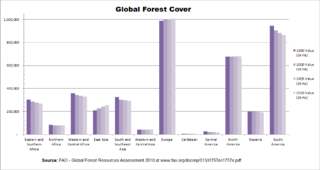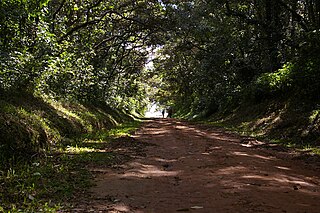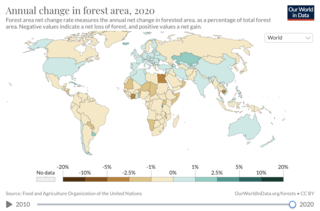
Deforestation or forest clearance is the removal of a forest or stand of trees from land that is then converted to non-forest use. Deforestation can involve conversion of forest land to farms, ranches, or urban use. The most concentrated deforestation occurs in tropical rainforests. About 31% of Earth's land surface is covered by forests at present. This is one-third less than the forest cover before the expansion of agriculture, a half of that loss occurring in the last century. Between 15 million to 18 million hectares of forest, an area the size of Bangladesh, are destroyed every year. On average 2,400 trees are cut down each minute.

A forest is an area of land dominated by trees. Hundreds of definitions of forest are used throughout the world, incorporating factors such as tree density, tree height, land use, legal standing, and ecological function. The United Nations' Food and Agriculture Organization (FAO) defines a forest as, "Land spanning more than 0.5 hectares with trees higher than 5 meters and a canopy cover of more than 10 percent, or trees able to reach these thresholds in situ. It does not include land that is predominantly under agricultural or urban use." Using this definition, Global Forest Resources Assessment 2020 found that forests covered 4.06 billion hectares, or approximately 31 percent of the world's land area in 2020.

Reforestation is the natural or intentional restocking of existing forests and woodlands (forestation) that have been depleted, usually through deforestation, but also after clearcutting.
Environmental issues in Nepal include a number of issues, such as deforestation, climate change, energy and species conservation. Many of these issues have been precipitated by rapid industrialization without major environmental regulation.

Deforestation in Cambodia has increased in recent years. Cambodia is one of the world's most forest endowed countries, that was not historically widely deforested. However, massive deforestation for economic development threatens its forests and ecosystems. As of 2015, the country has one of the highest rates of deforestation in the world.

Forestry in India is a significant rural industry and a major environmental resource. India is one of the ten most forest-rich countries of the world. Together, India and 9 other countries account for 67 percent of total forest area of the world. India's forest cover grew at 0.20% annually over 1990–2000, and has grown at the rate of 0.7% per year over 2000–2010, after decades where forest degradation was a matter of serious concern.

Brazil once had the highest deforestation rate in the world and in 2005 still had the largest area of forest removed annually. Since 1970, over 700,000 square kilometres (270,000 sq mi) of the Amazon rainforest have been destroyed. In 2001, the Amazon was approximately 5,400,000 square kilometres (2,100,000 sq mi), which is only 87% of the Amazon's original size. According to official data, about 729,000 km² have already been deforested in the Amazon biome, which corresponds to 17% of the total. 300,000 km2 have been deforested in the last 20 years.

From year 2000 to 2005, Nigeria had the highest rate of deforestation in the world as 55.7% according to the Food and Agriculture Organisation of the United Nations (FAO). Nigeria has biodiversity in abundance which makes it thrive consideringly well. In 1950s, large areas of land were quite reserved as a protected area but unfortunately they no longer exist. Biodiversity has been greatly destroyed by deforestation, degradation, encroachment and conversion of land into other uses due to the increase in demand of the fast rising population in the country.
According to a 2005 report conducted by the Food and Agriculture Organization of the United Nations (FAO), Vietnam has the second highest rate of deforestation of primary forests in the world, second only to Nigeria.

Deforestation is a major threat to biodiversity and ecosystems in Costa Rica. The country has a rich biodiversity with some 12,000 species of plants, 1,239 species of butterflies, 838 species of birds, 440 species of reptiles and amphibians, and 232 species of mammals, which have been under threat from the effects of deforestation. Economic advantages from cattle ranching, agricultural development, and logging have caused major deforestation as more land must be cleared to facilitate such practices. Despite government efforts to mitigate deforestation, it continues to cause harm to the environment of Costa Rica by impacting flooding, soil erosion, desertification, and loss of biodiversity.

Deforestation is one of the most serious environmental issues in Sri Lanka. Sri Lanka current forest cover as at 2017 was 29.7%. In the 1920s, the island had a 49 percent forest cover but by 2005 this had fallen by approximately 26 percent. Between 1990 and 2000, Sri Lanka lost an average of 26,800 ha of forests per year. This amounts to an average annual deforestation rate of 1.14%. Between 2000 and 2005 the rate accelerated to 1.43% per annum. However, with a long history of policy and laws towards environmental protection, deforestation rates of primary cover have actually decreased 35% since the end of the 1990s thanks to a strong history of conservation measures. The problem of deforestation in Sri Lanka is not as significant in the southern mountainous regions as it is in northern and lowland southern Sri Lanka, largely due to the nature of environmental protection.

Rates and causes of deforestation vary from region to region around the world. In 2009, 2/3rds of the world's forests were located in just 10 countries: 1) Russia, 2) Brazil, 3) Canada, 4) The United States, 5) China, 6) Australia, 7) The Democratic Republic of the Congo, 8) Indonesia, 9) India, and 10) Peru.

Deforestation in Indonesia involves the long-term loss of forests and foliage across much of the country; it has had massive environmental and social impacts. Indonesia is home to some of the most biologically diverse forests in the world and ranks third in number of species behind Brazil and the Democratic Republic of Congo.

Deforestation in Borneo has taken place on an industrial scale since the 1960s. Borneo, the third largest island in the world, divided between Indonesia, Malaysia and Brunei, was once covered by dense tropical and subtropical rainforests.

Central American countries have experienced cycles of deforestation and reforestation since the decline of Maya civilization, influenced by many factors such as population growth, agriculture, narcotic distribution and illegal practices. From 2001 to 2010, 5,376 square kilometres (2,076 sq mi) of forest were lost in the region. In 2010 Belize had 63% of remaining forest cover, Costa Rica 46%, Panama 45%, Honduras 41%, Guatemala 37%, Nicaragua 29%, and El Salvador 21%. Most of the loss occurred in the moist forest biome, with 12,201 square kilometers. Woody vegetation loss was partially set off by a plus in the coniferous forest biome with 4,730 km2, and at 2,054 km2. Mangroves and deserts contributed only 1% to the loss in forest vegetation. The bulk of the deforestation was located at the Caribbean slopes of Nicaragua with a minus of 8,574 square kilometers of forest lost in the period from 2001 to 2010. The most significant regrowth of 3,050 km2 of forest was seen in the coniferous woody vegetation of Honduras.

Kenya's forests are fragmented across the country, combined, forests cover over 37 million hectares. Out of those 37 million hectares, 2.1 million are woodlands, 24.8 million are bush lands and 10.7 are wooded grasslands. Kenya's forests are important at a global level as they host 1847 species of amphibians, birds, mammals, and reptiles of which 4% are only found in Kenya. Beyond its fauna, Kenya's forest also hosts 6505 types of vascular plants, with 4.1% only being found in Kenya. Today Kenya faces high rates of deforestation which endanger both its fauna and flora. It has been estimated that since Kenya's independence in 1963 the forest cover has dropped from 10% of the nation to 6%, losing approximately 12,000 hectares annually. These levels of deforestation have impacted Kenya as they rely on the forest for the storage of rainwater, the prevention of flooding, the fertility of the soil, and the regulation of climate conditions. The World War II period and its aftermath made it clear to British colonial administration that reform was needed to sustain Kenyan forests. One of the first steps for conservation took place with the 1941 revision of the Forest Ordinance that passed legislation to create forest reserves and create a committee with professionals on matters of conservation. By 1950 the forest department had gained control of 100,000 acres, but it had a difficult time sustaining the conservation of these areas; it required meaningful policy to meet the constant attention these areas needed.

Deforestation in Papua New Guinea has been extensive and in recent decades from 2001 to 2020, Papua New Guinea lost 1.57Mha of tree cover, equivalent to a 3.7% decrease in tree cover since 2000, and 1.15Gt of CO₂e emissions.

Deforestation in the Democratic Republic of the Congo (DRC) is an environmental conflict of international importance. Most of the deforestation takes place in the Congo Basin, which holds the second largest rainforest of the world after the Amazon. Roughly fifty percent of the remaining rainforest in the Congo Basin lies within the boundaries of the DRC.
According to a report by the Food and Agriculture Organization of the United Nations, Myanmar lost 19%, or 7,445,000 hectares, of forest between 1990 and 2010. With forest covering as much as 70% of Burma at the time of independence, there were only slightly more than 48% forest cover left as of 2014. The deforestation rate of Myanmar has declined from 0.95% per year in the years 1990–2010 to about 0.3% per year and deforestation in Myanmar is now less than other countries of the region such as Indonesia or Vietnam, but still remains an important environmental issue. Three main factors contribute to continued deforestation: unsustainable and illegal logging, unresolved land rights and land disputes and extensive agricultural development.

Deforestation is a primary contributor to climate change. Land use changes, especially in the form of deforestation, are the second largest anthropogenic source of atmospheric carbon dioxide emissions, after fossil fuel combustion. Greenhouse gases are emitted during combustion of forest biomass and decomposition of remaining plant material and soil carbon. Global models and national greenhouse gas inventories give similar results for deforestation emissions. As of 2019, deforestation is responsible for about 11% of global greenhouse gas emissions. Carbon emissions from tropical deforestation are accelerating. Peatland degradation also emits GHG. Growing forests are a carbon sink with additional potential to mitigate the effects of climate change. Some of the effects of climate change, such as more wildfires, may increase deforestation. Deforestation comes in many forms: wildfire, agricultural clearcutting, livestock ranching, and logging for timber, among others. The vast majority of agricultural activity resulting in deforestation is subsidized by government tax revenue. Forests cover 31% of the land area on Earth and annually 75,700 square kilometers of the forest is lost. According to the World Resources Institute, there was a 12% increase in the loss of primary tropical forests from 2019 to 2020. Mass deforestation continues to threaten tropical forests, their biodiversity, and the ecosystem services they provide. The main area of concern of deforestation is in tropical rain forests since they are home to the majority of the planet's biodiversity.





















